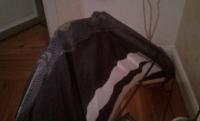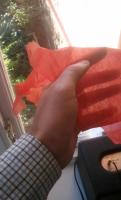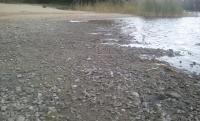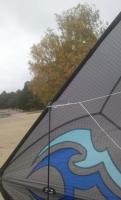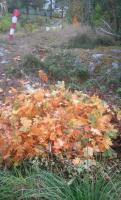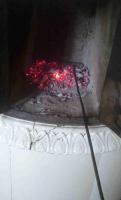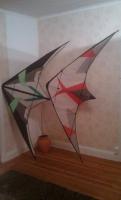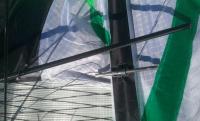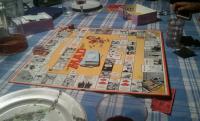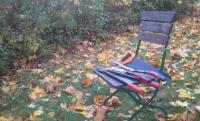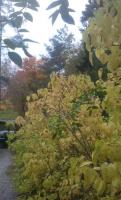-
Posts
580 -
Joined
-
Last visited
-
Days Won
27
Content Type
Profiles
Forums
Gallery
Downloads
KL Shop
Blogs
Articles
Everything posted by Exult
-
To keep your kites and other "normal" checked in luggage in the same bag sounds very practical. However I got two questions about the "Liquid Force Wheelie Wakeboard Bag": If one did not pack any long stiff objects inside the wakeboard bag, held it by the handle and rolled it on it's wheels, would it then essentially keep it's shape or would it collapse and fold double? When checking in this bag, will it most often go with ordinary checked in luggage or will it need to be checked in as special luggage such as sport equipment, skis, golf clubs...and be fetched separately?
-

Virtual Freestyle Practice, New Camera, and "Push Axels"
Exult commented on Happyspoon's blog entry in Learning to Fly Dual Lines
>Every time I watch the footage of my sessions I can see line tension screwing up the trick. By slack, do you mostly mean running down with the wind or flinging your arms forward? Could a snappier execution of a trick substitute at least some of the "running with the wind" or large arm movements? Personally I'd say that my snap turtles work with little arm movement or in harder wind. However I don't know how/if snappier execution can substitute slack when starting a fade. > Less than a week left to get an entry in! I'm trying to get an entry that... I've said it before and I say it again - you are very "kite on"! > I've also been working a bit on 'Push Axels' -- Axels started from a 180 90 degree push turn instead of a stall. Your push axels (at 12:24 in Slide-Axels-Fades on My Prism Quantum... video)- they look fun. As described in the Push Axels - Simple Way... video push and pull the lower wing without a pause where the kite is stalled. This is like a spin axle, but with a short push spin and you axle with the same hand as you used when controlling the turn/spin. Does the omitted stall affect in what wind range that the trick works best in? I ought to figure them out and try them. Also I like the side slide at 15:05 where you stop the side ways movement and then resume it by angling the kite. For me (without knowing if there are any official definition) a push axel is somewhat different. Start from a stall, then rather than focusing on pulling on one side instead push on one side so that wing sinks back and around. It is probably so that you slightly almost without knowing it will pull the front wing when the other sinks back. When the rear wing is pointing from you after the kite has completed 1/4 revolution you can also pull on the rear wing slightly to help it forward again. This was something I did regularly ... by end of the nineties ... time to do some rehearsal. Talking about the Slide-Axels-Fade video again you seem to have gotten the fade launches going and be reliable as well (at 5:32 e.g.). When I do fractured axels I kind of feel a bit in a hurry (and I only use one line when pulling the kite on its back) and the reliability is not what I want. Fade launches work OK (I use two lines to pull it on it's back here). Is there any difference (in feeling) when doing these two fade tricks? > From that list I turned what I thought had been constant failures at Half Axels into repeatable successes with Rixels! This is the most reliable way I have right now of getting into a turtle. For me the turtle initialisation learning order was (is?): 1. Fly to the top of the window. Then start with your hands close to your shoes and then quickly throw them (hands) upwards as high as you can reach. 2. Fly to the top of the window, then quickly and lightly pull on one line (the kite will flip). 3. Doing snap turtles. Here my quite pitch happy (or turtle prone) Maerstrale was of help when learning. 4. From half axels and cascade attemps tha might end in a turtle "by themselves". 5. From a spin stall/hard turn. When the nose is pointing upwards, make a sudden release. The one I use most today is snap turtle because I find it reliable, quick and can be performed with little effort (naah... this sounds like I'm too comfortable).- 7 comments
-
- 1
-

-
- fractured axel
- side slide
-
(and 3 more)
Tagged with:
-
Judging from the status of another "newbie" member (however inactive in the KL forum for some time), the word "newbie" should perhaps be considered as an honorable title?
-
Ahh ... had no idea that I would learn some kite customs today. To my defense I'd say that I don't have much of a local kite community to learn from (and that I've not been doing any distant kite festival travelling). In a way it sounds like the feather is also a kind of souvenir or a mark of a kiter.
-
Thank you for your reply and welcome here (personally I think it is a bit extra fun when a new dual line kite pilot shows up here, since it is also my "thing"). Does the feather have a function other than being decorative (and it would be nothing wrong with that - I'm just being curious)?
-
It is a what?
-
Can line leaders make (dual line) kites more wing tip snag prone than a kite without? For trick that rotates the kite in other directions than pitch, axels e.g. can the larger mass of the leaders cause the leader to be flung outwards around the wing tips?
-
I don't think that the span-width says it all. The manufacturer rates the speed higher than it's trickability for all the sizes of the Topaz that was (?) available through their web site. For a kite that is more speed/power than tricking, I'd expect that it is correspondingly shallow (short stand offs) and with nose angled backwards. There might even be a billow towards the leading edge? Also kites less than 3m (10') can make you stop yawning as well. See and listen to these Fazer XL (2.8m) and Fazer XXL (3.6m) videos (the Fazer kites are sold as speed and power kites). Although these pilots doesn't do any tricking (yes you can do it, though I've only tried it with the Fazer XL myself) I wouldn't say that they sit down because they are sleepy: So majestically slowww... But you'll need to be at least 30ft off the ground to do a fractured axle to fade, to not scrape the nose In the Korvokite site where they sell the Wolsing kites Steiki and Flaki they say: "Trick- ,Speed-, and Powerenthusiasts would be disappointed, even if the bigger versions, with a steeply adjusted bridle, are able to pull the pilot rapidly on his backside. But this is not the intesion. Günters objective was a kite for pilots, who want nothing else than to enjoy the majestic appearance of a Wolsing kite." Pricing of the Steiki is a bit odd, straight forward and simple. You pay 1.5EUR per cm span-width for the Steiki! Steiki is available up to 3.5m and Flaki up to 12m. In the book "Grosse Lenkdrachen - Entwerfen, Bauen, Fliegen" Günter Wolsing also describes how to build a larger 4.5m version of the Steiki. Side slides and axels with a 3.5m Steiki:
-
So what was this for kind of a kite? First I thought I found it (Topas, Space kites): https://www.youtube.com/watch?v=PyucHiW1-BI http://www.spacekites.de/ProductDetail.aspx?prod=100116&cat=10 or its larger version https://www.youtube.com/watch?v=kesK3CmF7aE but the relative length of the spine doesn't match. B.t.w. I believe that they are no longer active. I e-mailed them about 3/4 years ago without any reply. Looking on dates on the site, activity seemed to have ceased 2014(?). Update: I thought that the Space kite web site just happened to remain while their activity had ceased. Now (December 2016) I saw that there was a slight update/change in their page. I also saw that Metropolis Kites was offering the 3.4m Gladiator. However the trailing edge differed somewhat from the Space Kite's Gladiator. On the other hand looking on the three different colors of the Gladiator in Metropolis Kites, the trailing edges differ there as well (though they shouldn't of course - color should not affect shape of kite).
-
I had to examine this, so yesterday I brought the Alien to the field. I initially found it difficult (didn't work i.e.) to LE-launch it from anywhere in the window. It just fell over to the wrong LE instead of taking off. Only towards the edge of the window (with the nose pointing outwards) and by doing some less standard launch input could I make the LE-launch to work. Instead of holding the top wing closer than the lower wing (~steering from ground by pulling) and then pull the lower wing in action by sweeping your arm as normal, I replaced the lower wing sweep by running backwards from the kite (still maintaining the pull on the upper wing). Success-ratio of launches towards the end of the window: 2/5. Yes, I found it tricky.
-

Bridle Adjustments, Wow (featuring, new green quantum)
Exult commented on Happyspoon's blog entry in Learning to Fly Dual Lines
Are you actively putting the kite on it's back here (at 0:16 and 0:30) by axeling? If so congrats for that level of control. ... When seeing it for the second time to get the times of extra interest I noticed that I had missed your comment (at 0:33): "Grr the dreaded half axle to turtle". OK, so at least the second turtle wasn't intentional. Well for an observer it could have just as well been on purpose and it could also have been the start of another trick (I tell myself because I someday would like to learn to initiate a lazy Susan that way). I also like the part where the kite is darting downwards from the top of window in a straight line (at 1:49) and from that you quite abruptly initiate a side slide outwards (?) towards the edge of the window. -
At 1:17 in the video you start with the nose almost pointing in the horisontal direction about two kite span widths from the ground. You then axel into a wing tip stand. That looks nice. Do you have any hints here? You just axel and walk forwards? At 1:27 you make another massively height dropping axle (although ending in the air instead of the ground), but seems to start from a spin stall with the nose pointing in the same direction as when ending the axel. I find the yoyo wrap up and later "un-yoyo" starting at 4:17 is very clear. I'm not into yoyo stuff, but this is inspiring. During some future un-wrap (heading down, flaring and then pulling as you did here) I'll certainly avoid to go directly into a fade (as in the video) to avoid too much frustration. My thoughts are lead to a colorful beetle (and I don't mean the beginner Beetle kite here) with its inner wings extended or perhaps a colorful decorative moth.
-
Sorry the quoting feature didn't work, so I needed to use " > " to show the quotes today Happyspoon you have made a very organised and well documented account of where you are today! I'm sure others who are starting out can really use this to get inspiration and an idea of what hopefully awaits! > I’m pretty solid at holding a slide, but not at ‘pulling’ the kite past the middle of the window to keep sliding. I have pretty much no practice sliding from the center to the edge of the window. I can't either. However, to some extent, especially with my Tramontana, I can to some degree while sliding sometimes go a bit past the centre towards the other wind window end during the right conditions. This is what I try to do: have the arm connected to the trailing wing tip extended much and then move from the kite (but I think that you already doing/discovered that). My thoughts (for what it is worth) is that the sideways angle (one wing tip being closer than the other) drives the kite sideways and can also do that past the centre of the wind window, but all the way to the other wind window edge – no way for me. > I think the 'sharpness' of the pull makes much more of a difference than the intensity. I can axle with one finger no problem this way. On the other side, a longer pull almost always ends in a wingtip snag/wrap. Even when the tip doesn't wrap, long pulls rarely get the kite to rotate all the way around. Do you mean that a sharp pull is when you just make flick on a line and the intensity is how much momentum your arm/hand gets (and how much of that that gets transferred to the kite)? I wish to find a table or a definition list (preferably by someone well familiar with English), that describes/defines flick, pop, tug, lash... Would terminology be needed for pushing and giving slack as well? With this finger (flick?) axel there is no risk that the kite will turtle? What I'm thinking of here is when you initiate a turtle by flying high up in the window and make a short light quick tug downwards (and the kite should then tip on its back). > ...a well-executed FA. Flatter axles would help I haven't thought of this more than lets make a decent axel. I really should try this out (how the fade-init is affected by the axel)! Most of the time when initiating the fade I only tug on one line, but flatter axels might perhaps still help? > Half axles- phew, what a challenge still ... I tend to try and pull the kite right into a flare which I think means I'm pulling for too long. Did this part about pulling into a fade refer to the second tug? The problematic part for me is the quick pull on the wing that is on the top after the axel movement - i.e. the quick pull on the "new" top wing. So anything you learn about the timing and snappiness of the second tug I'd like to hear about. My ideal is to keep the arms low at all times during the tricking. My guess is that it would be easier to learn the movement with a high hand during the pull on the top wing after the axel - but more difficult to "unlearn". I also wonder if this second pull on the wing that is on top during the latter part of the half axle is the "kick" that gives the trick the alternative name - the "kick turn". Is it so that there can be no "kick turn" without it? As I said before I'm not really focusing on them now. However I've managed to make seven cycles of a half axel cascade on my Hydra consisting of most likely improper half axels without having the kite going on its back (rixeling?). But I think that this more tells something about the kite rather than about my ability to do a half axel cascade. > Cartwheels My current goal is to make calm, relaxed and minimal input cart wheels for high aspect ratio kites. Should try my 4D 6m lines set so that I get closer to the kite and see what happens. The risk of breaking the lines (25kg and noo sleeving on the kite side) should make me extra careful in minimising the input. > It might be that I'm always practicing in pretty low wind but I'm finding fade launches tricky. I suppose that you are already walking backwards. In very low wind with my 4D I need to do jogging backwards to maintain the fade (which I find tricky to combine with the fine inputs). > but for some reason didn't try half axles on it Somehow (not meaning to sound offensive) I don't think that that is so important. There are so many aspects of kiting to explore. Perfect an "old" trick or try it with varying inputs. So many kites to try out the different tricks on, so many tricks and so many possible whether conditions to examine "the moves" in. Seeing what you have achieved in a short time and how structured and persistent you have been I think that there will not be a very long time until you can do them as well. Also, not to forget, when doing advanced kite flying like this there is a need for just rehearsing as well - both more long term and also at the start of each session during the warming up. I've also had thoughts like "why on earth didn't I try this or that during my last session", but I tend to be slightly more relaxed lately. Even if you do active learning you can't do everything at once. > "provoking the kite" Failed tricks are one source of getting the kite provoked (~testing various inputs and be open regarding the usefulness of the outcome). To better understand trick descriptions (such as http://www.idemployee.id.tue.nl/p.j.f.peters/kites/basics/funcidx.frm.html ) it is of use to know possible movements and part of tricks I believe. Provoking the kite/testing out is a way of getting small building blocks of understanding and practice that then might be identified in or as tricks. As a beginner there is more random tugging/slacking and with time more targeted experimenting. The below are tricks/movements I have found out (and might continue to work on) by trying without knowing what the outcome could be or as a result of a failed trick: Snappy turtels The first time I saw one was in the promotional VHS that came along with my Jam Session (or was it in a promotional section of a trick video?). In a short sequence the Maestrale flew along the ground, making contact without stopping and then doing a short snap turtle as a part of the ground pass. For my un-trained eye it looked like a dry leave driven forward by an autumn storm. Needless to say - this made an impression on me. However I had no idea on how a snap turtle was performed. Snap turtles didn't come as a result of a series of sessions of trying to do them, but more: "Hey what is this? This didn't tangle the line and it could be repeated and then refined." I then later realised that I did a part of that tumbling autumn leave sequence. Rixels (from failed half axel attempts) It was a long time ago I tried them, but something like this - do a sloppy half axel attempt and be somewhat heavy on the arm that you pull the half axel with (really think I ought to go out and attempt them before sharing how it should be performed since it was a while ago). Same thing here, I was already doing them at the time that I read the description. Notice that the failure of doing one trick (the half axel) lead to another trick (the rixel). A similar "turteling" trick (as above) but starting from a start of a downwards turn Once again I should try this out so that I could deliver a fresh description (but I won't now). The trick is similar to the rixel, but you initially fly upwards and begin to turn with one hand and then axel with a bit heavy arm (i.e. the other arm than the arm that you are pulling with when doing the turn) as you didn't really mean the axel. This trick is also not from attempting to perform it. Possibly it was from a failed axel attempt. The feeling of the trick (or rather in the arm) when pulling the kite on it's back is a bit like the weary feeling of a really long kiting session. When writing about the rixel and this trick I realise that I've been neglecting them when working on tricks that I learnt more recently. Axel or half axle into a flare and with the other hand investigate a second pull Vary this second input. What determines if the result is something like a half axel, rising half axel or a fade? Two kites that felt good doing these tests with were the Illusion and the Alien (should try ut on the more recent kites again). To get me into mode to investigate the effect of the second pull I start to think about the trick when the kite is already flared. I don't think so much on the axel part, but do only small movements on the hand that pulls the axel – possibly axel mainly by only angling the wrist from an inward position to a straight wrist position and back again. I hope that I one day will get useful results from this. In the above video "Getting closer to half axels..." I think that you already are investigating the second input. Sleeping beauty This is another example of a trick that I learned from testing without not really knowing what to expect in detail. As I wrote in a previous blog entry the unlikely incredible thing happened that this trick just worked the first time attempted (leaving me to figure out what happened and how it worked) and only failed once during the first session doing this trick. Funny, just commenting on your statement about "kite provoking" started/continued a lot of trick thought/planning. The above are some of the things a intend to continue to work on and evolve. > I went out a few times to try night kiting! You are so "kite-on"! I had the idea but I've never tried - for years. How is it? Would you say it is a nice thing to try or is it a valuable because that it offers more sessions during the darker time of the year. Do you learn as much from a session in the dark as from one in full daylight? Was it so dark that flying have been possible at all if it wouldn't have been for the lights during the session when you were out? About the night video I must say that it looks nice, giving you the kind of relaxed feeling of watching fish in an aquarium. >(RobB wrote) I have an Alien, too, but we don't get along, and it stays home. I like my Alien (though admittingly I've not used it much during the last six months). It can do double axels ( http://tricksparty.info/en/tricks-in-english/46-double-axel-group-4 ) without any input between the axels (haven't seen that in other kites that I have). It encourages you to try and toss it around. It gives you few line snags. In my opinion it is not so bad in low wind either if you trim it by moving the stand-offs inwards (can't remember if I did anything with the angle of attack as well). Finally and obviously – it is decent in high wind as well. Yes, it feels a bit different, but I have difficulties in describing it. Perhaps because I don't have many kites of that size (span-width 189cm) to compare it to. >(RobB wrote) Finally, about the weather watching... tell me that you can't drive past a flagpole without looking up to see which way the wind's blowing ?!? 8) I'm into tree top watching to get an idea of the wind, especially birches (with their long hanging twigs) when available. >I took your advice and did a bunch of prolonged fades on my Ozone yesterday! I'd would like to try that steering as well! This is silly, but that video (Faded fractured axels...) triggers something in me that resembles a competitive mode (Have been working with the FA fade stuff for 1.5 years and have not been thinking of that steering! More focused on start and maintaining it.). Funny, when playing tennis, the tennis matches are not the main thing, so I don't consider myself to be much competitive (well not that I mind the times when playing well or winning).
-
Very nice flying indeed - sure you had a summer long kite break? The figure flying was really evident/convincing/clear! How long lines did you use here? Or perhaps Paul Simons "Slip sliding away" ( https://www.youtube.com/watch?v=U7PBjKzaQEw Both with and against the wind (as at 1:32) the side slide could be controlled with the leading or trailing edge? As I recognize that going to a wing tip stand from the launch position can take a few attempts (as in 3:53) I consider to see if it is possible to go a wing tip stand from ground via an axel instead. The rest of your tricking - just inspirational!
-
How does dog stake flying feel like? Is your right hand controlling the right wing? Any pitfalls? Any recommendations to somebody else trying it? I've had the following thoughts about dog stake flying: It's for those that are good at all advanced tricks and seeks new challenges (and therefore is nothing for me today - but it seems like you just bought it and just started to use it?). On the other hand it would give an opportunity to watch how tricks really works from a really close distance and from an arbitrary direction. Could it be helpful for e.g. study in detail what really happens in a cart wheel when trying to minimise the input? Would one then need a second dog stake to make things normal again? I could imagine that there is some understanding of tricks that could be gained from seeing them from close distance from various angles.
-

Exult's chunky log - autumn/winter 2016
Exult commented on Exult's blog entry in Exult's Gentle Breeze
It might be so that your hands already know a snappy turtle initiated from horisontal flight which could be used in harder wind. Consider your early attempt of a half axel http://kitelife.com/forum/blogs/entry/194-lunchtime-slides-stalls-and-a-bunch-of-half-axle-practice/ - you instead briefly went into a turtle. Perhaps continue to work on this snappy turtle work that you accidentally started? Another more obvious exercise would be to do a snap stall with conviction and, yes, snappiness while running downwind. I assume you would use the Quantum for this harder wind session? I've never tried one - but from the discussions it sounds like it would have a bit heavy frame which would help tricking in these winds. Finally, you don't need to develop strength. It is not strength as in power kiting. The inertia of your arms from a snappy movement can be enough to snap stall and turtle in higher wind. I'm not sure we are discussing the same thing - by the "fall over" I meant the 3/4 downwards turn of the start of the side slide which the Hydra does almost by itself (though I'd like to verify that during better conditions). (This is a behavior that is shared by all my kites designed during the nineties (with the possible exception of City Session). On the other hand the Infinity, Maestro 3 and 4D instead want to make a very wide turn when turned downwards at the edge of the wind window. Yes they can make sharp turns elsewhere and I should figure out if I can make (force) them to do the turn at the edge as well.) That thought (about separating the log dumps) has struck my mind recently. Originally I intended to make very short flight log entries - just a couple of lines, possibly not even full sentences everywhere. Well it didn't go that way. You need to test before you find "a working concept"/"your form"/"something that works well". Initially I chose between having a separate blog for the flight logs or doing it as now have implemented it (by including it all in a blog entry + comments). Perhaps this suggested third way of having a blog entry per log dump makes it easier to find the new log dumps and also makes the size of the blog entry manageable (though you miss out some organisation when the log dumps are not any longer bundled in to a blog entry). I think that I'll go that way (with a blog entry per dump) after "Autumn/Winter 2016" blog entry period is finished. To on the other hand change the existing (large) blog entry blog entry would be difficult. Splitting up the current blog entry into new blog entries corresponding the different log dumps and then include the comments without affecting the time stamps is not something an ordinary KL member can do. This was something that I came up with during the work with the hedge. A case of hands working and mind wandering. And I thought that I was original... -
Hello and welcome! Old kites can be both interesting and fun. I like variation that allows you to "discover" a trick on one kite and transfer it to the next. When looking for info about the Utopia and Tricktail they sounded interesting. Utopia: http://www.kitepower.com/reviews/utopiareview.html https://www.youtube.com/watch?v=mxNHQZQ9-qM Tricktail: https://www.youtube.com/watch?v=Uoz63dEwd1E What kind of kites are you most likely to grab when going kiting? I guess this must have felt like a final decision at the time. I've never been able to do this (with the exception of a bulky failed homebrew garbage bags and bamboo sticks dual line). But on the other hand I had just a few kites from the early years to store during my long intermission (getting a family/children.). And finally, your wife seems quite supportive of your kiting.
-

Exult's chunky log - autumn/winter 2016
Exult commented on Exult's blog entry in Exult's Gentle Breeze
The second log dump Session list: Breakthroughs of destruction Low/zero wind session with the 4D in a new park Doing basics and ground work with the Shadow The day of the good looking axles - a surprising light wind success First time with the Hydra and (experimental) flying without intention Conclusions can be found last in this comment/log dump ¤¤¤¤¤¤¤¤¤¤¤¤¤¤¤¤¤¤¤¤¤¤¤¤¤¤¤¤¤¤¤¤¤¤¤¤¤¤¤¤¤¤¤¤¤¤¤ Breakthroughs of destruction Mon Sep 12 12:54:25 CEST 2016 GB forecasted 3-2 Maestro 3, Elixir, Tramontana - all on 20m 40 kg lines Wind was a bit on the harder side first, but then really quickly died out in the evening. It was slightly frustrating, when finished assembling a suitable kite (Elixir) for the new lower wind, it was time to assemble the next kite for yet lower wind. Maestro 3 Initially a bit hard wind with a hint of frame deformation in the gusts. Rock and roll and fun flying. Not much gentle touch here. The maestro 3 had no problem in staying in a turtle, however it didn't lay still in a turtle, but wobbled back and fourth and also changed the pitch of the kite. Doing the Lazy was just a question of waiting to the right moment when the backside of the kite was visible and the kite was (left-right) horisontal and then pull on one line. The beach/lawn is quite smooth and the wind came from the sea - yet the turbulence was there. For the moment I didn't mind the tumbling - it kind of suited the scene - felt wild. However for other moods, is there a way to dampen the random oscillations of the turtles in higher wind? The wind speed went down so I could practice holding fades for a while - were by no means fantastically performed, but it felt good. But everything has an end - a brief glimmer, a reflection of the last direct light from the sun for today, was seen in front of the kite nose. It was the spine that now had made it through the worn out nose and the end-cap had fallen off. Elixir I assembled the next kite for the now lower wind. It was hardly worth it - wind dropped again - next kite! Tramontana Wind continued to drop - too comfortable/too little time left, so I didn't bother with longer line set - stuck to 20m. Time to ponder over the preserved momentum from the turn - can't say I got it. More like managed to make it look not ugly, but the old way of making a 3/4 turn downwards still looked nice (but on the other hand almost all stalls and slides looks good with this kite). I still would like to learn the "speedy slide way" by flinging the kite in the downwards turn (as discussed in the topic http://kitelife.com/forum/topic/7443-trying-to-do-the-side-slide-with-a-two-line-kite/ ) in several places in the wind window. When disassembling the kites I noticed that there were two smaller holes in the Tramontana nose. The end caps of the upper leading edges had fallen off and the edges of the end of the carbon tube had worn two symmetrical holes on either side of the spine. These end-caps were quite short - should they have been longer or just better glued? Two holes in the Tramontana nose. The end caps of the two LEs had fallen off exposing the fabric of the nose to the sharp edges of the carbon tube. ¤¤¤¤¤¤¤¤¤¤¤¤¤¤¤¤¤¤¤¤¤¤¤¤¤¤¤ Low/zero wind session with the 4D in a new park Sat Sep 17 11:15:00 CEST 2016 KG forecasted 1 4D 18' 50# lines The 4D session Me being close to this untested small field/park by the sea was caused by driving my oldest daughter to catch a small ferry to go to town. The lawn of the park was 20m max physical 15m max practical line length. There were a lot of families with children in the park, but the lawn was practically empty (many seemed occupied with building some obstacle path in the steep slope around the lawn). Wind was really a disappointment. The forecast spoke of 1m/s mean and 5m/s in the gusts - ha! The dew was still here and there in the lawn. Releasing relatively dry seeds of an dandelion gave a wind speed of about 0.3m/s (and at one measurement they just fell straight down). Remembering my previous attempts with the 4D in zero wind about a year ago, I actually considered just going home. Here in a park it could turn out to be a humiliating experience. Well it wasn't as bad as I feared and was for certain some good physical exercise. By end of the short (40min?) session keeping it in the air was a bit more fluent. Did a couple of axles and a few 360deg. The 360deg was not reliable enough to be used as the main way of gaining ground. Most often I needed to grab the kite itself to gain ground, but with 18' lines and a small field the walk of shame (or gain?) is short. Thoughts about low wind kiting Really, why should this much running around of the behalf of the pilot be required? When 14 years old, I built a balsa tissue model rogallo wing "hang glider" of my own design. The spanwidth was about 30cm (a foot for you over there). The spars were about 1.5mm square balsa sticks. The sail was made from thin (esaki?) tissue used otherwise for coating model aircrafts. It had no stand-offs but had balsa bows/arcs that had been steamed, then bent and allowed to dry so that they preserved the bow shape. The balsa arcs held the sail roughly in place. The rogallo wing was constantly assembled glued together with balsa cement. I never used this as a kite - just put a small weight under it where the miniature pilot would have been - and then watched it when it slowly flew like a glider across a large room. At this time I had never seen a stunt kite so this was all I did with it. How would this have worked as a kite during a no wind day? So today instead of doing the healthy physical exercise I'd much like to have had a slightly larger kite and a metre or two longer lines made of just a few strands from a kite line. The spars should not be solid as for the 4D but really really thin tubes and only the lightest fittings. Everything contained in a hardcase during transport. I guess it would be more practical to settle for any of the suggestions I got from @Wayne Dowler in http://kitelife.com/forum/topic/7468-karma-prism-red-4d-10-3-16/?do=findComment&comment=60646 Tissue for balsa models ¤¤¤¤¤¤¤¤¤¤¤¤¤¤¤¤¤¤¤¤¤¤¤¤¤¤¤¤¤¤¤¤¤¤¤¤¤ Doing basics and ground work with the Shadow Sat Sep 24 17:58:43 CEST 2016 GB forecasted 2m/s HQ shadow 20m 40 kg lines The field should have worked for the wind direction in the forecast, but in reality it was very varying and somewhat dirty wind. Not a really good start, had difficulties in especially in doing fades but much else as well. Trying the sideways fling of of the initial turn of the side slide - well a shadow haven't got much mass to fling, but ok I was more aware of this part of the trick. A Shadow on the beach. No there is no tide that you can notice in the Baltic sea/archipelago. However the low water level made a few extra meters of the beach available. Lazy Susans are a nice and comforting for the trick self confidence with the right kite. I hadn't done any multi lazies before (and did not really today either) but when the kite was sinking down when being in a turtle I did three. How close in time should the lazies be to be considered to be a multi lazy? Sometimes it took a long time for the turtled kite to land - how can this be utilized and controlled? I think (but need to study this again) that the nose it quite low when/"in spite of" there is some tension in the lines (but how could the turtle be deep then?). It turned out that I could do the sliding prone pigtail slightly better by locking it more (thanks again @Wayne Dowler), so it was only needed to correct it two times during the session, but there is some kind of slippery stuff there I believe. Now I have cleaned the troublesome bridle part twice with concentrated manual dish washing detergent - lets see what the effect will be. When doing bridle adjustments to correct for the sliding pigtail, I could just as well try some settings out. Usually I don't adjust the bridle except for very light or very hard wind. It is like I'm impatient to have the normal flying going and therefore don't start with bridle tweaking unless I have a good reason to. This have meant when adjusting it I've always moved the nose towards me (or returning to factory settings). So this time I decided to do the opposite - adjust the nose way back (even though the wind was quite light). Flying felt much strange initially with very much over-steer, but this was something that could be largely handled. Returned to normal setting after a while. I then focused on something I've not been doing for a long while - the stall and nothing but the stall. Just let the kite freeze in it's position in a point in the sky. Stalls have for a long time only been a part of a trick with a short duration (well for the exception side slides then and landing by slowly lowering the kite). Maintaining the fixed stall was not very good - practice much needed. Another exercise that came to my mind was because of something I suggested in a "getting acquainted with the ground set of exercises" ( http://kitelife.com/forum/blogs/entry/200-exults-chunky-log-autumnwinter-2016/#comment-321 ). Same thing here, I have not been focused on doing this - more or less only focusing on on fade launches when starting from a "ground flare". I had actually forgot to do the proper set up angling the kite on the ground (which I actually did during late nineties but kind of forgot during my second "kite wave"). This exercise was quickly rewarding (as opposed to the stalls) and resulted in good looking belly launches. Another ground work shortcoming is to go directly into a wing tip stand - I never managed to go from an ordinary launch position quickly and without hesitation into a wing tip stand. And also the tip-stabs needed (and will need) some working on as well. There was much working on basics today, but I found that it was a good thing to do - no matter if it left much to desire to look good or if the exercise was quickly rewarding. Too much focus on "fancy" tricks makes you forget the basics which well performed can add to your over all appearance IMO. An early sign of the autumn - the birch tree is preparing for winter. And yes the Shadow is in the foreground. Lilacs during non-flowering off season - still looks beautiful. ¤¤¤¤¤¤¤¤¤¤¤¤¤¤¤¤¤¤¤¤¤¤¤¤¤¤¤¤¤¤¤¤¤ The day of the good looking axles - a surprising light wind success Sun Sep 25 18:46:09 CEST 2016 GB forecasted 3m/s Prism Alien on 20m 40kg lines Prism 4D on 17m? ??kg (the original lines) The Alien part of the session I very much hesitated before going out on the second kite session for the weekend. Earlier this day I had sawn down a small maple tree in a steep slope by hand and chopped it into logs, so I longed for some rest. Besides my wife had made an apple pie and there was a kind of spontaneous family just being together time. No, I thought I can't give after for being a little exhausted and I can always limit the total time to 1.5h or so (perhaps)... Everything from the tree, except for every branch more narrow than a finger, eventually ends up in the tiled fireplaces or the wooden stove heating the house. Besides the residues from the tree gets very manageable, no bulky branches remain, just twigs and leaves. Testing a tiled fireplace before the winter. The whether forecast did it again, much less wind then in the forecast. I had just removed my Shadow from the kiting bag (due to the forecast) and now assembled the Alien more or less out of principle . It was a long time since flying the Alien so I felt a bit rusty on this kite and the low wind made me need to work to keep it airborne. Adjusting the stand offs to an more outward position helped a bit. After a while a kind of felt in control doing the basic flying. Did also FA to fade transition when I became more comfortable to see if I could transfer my more recent tricking abilities to this kite. Later flaring the Alien required quite much input - was it the kite or the kite in combination with the low wind? Should experiment more with the pull/release of the flare to also be able to handle the few kites/conditions that requires more input. Perhaps a spin-off would be a better flare technique for any kite? Axels are nice to do with the Alien. It got an tendency to do them flat and sometimes they even come out double. It is prone to lower the nose and effortlessly carry on with the axle rotation. Two things to practice another time with the Alien pops into my mind. Learn to do the double axle with a decent success ratio. The other is to transfer the good axels of the Alien to other kites by doing axels first with the Alien for a minute, then the other kite, then the Alien... The 4D part of the session Eventually the light wind flying with the Alien became too difficult as the wind dropped further. Guess which small kite I didn't notice when cleaning out the light wind kites in the bottom of my kite bag? - Yes, my 4D! I'd say that the tricking with this kite has been much limited. One reason is the light frame which require inputs much different from the kites I've "historically" have used. Another reason is that I haven't used it more or less unless I've been forced to do so by the conditions/circumstances. It could be an extremely limited space, in a hurry during travelling when my family wants to go to the restaurant or something or in no or close to no wind. After working to have the Alien remaining in the air it felt like a luxury to use the 4D - you did not need to work for the action. In the middle of the wind window you could even take a step forward to reduce the pressure on the sail. Inspired by the successful flat axels with the Alien I carried on to see if I could do similar axels with the 4D. It happened almost by accident when turning downwards at the edge of the wind window as if initiating a side slide, but instead only go to a "deep stall" (nose down and and outer wing a bit back) and then do a light pull the outer wing to do the axel. Further inspired by the success of the good looking axles I had a go at the fade launches. After getting used to the small movements required for that one, the fade launch worked as well. This session everything seemed to work with the 4D, so why not trying out Lazies? I didn't exit the Lazies, but I allowed them to sink all the way to the ground. It was possible to do several rotations before the 4D reached the ground. This day I felt that the 4D started to behave like a "real kite". The two light wind heroes of the day (though not within the usual wind range for the Alien). ¤¤¤¤¤¤¤¤¤¤¤¤¤¤¤¤¤¤¤¤¤¤¤¤¤¤¤¤¤¤¤¤¤¤¤¤¤¤¤¤¤ First time with the Hydra and (experimental) flying without intention Sat Oct 1 19:05:04 CEST 2016 GB forecasted 5m/s (+quite hard gusts) ITW Hydra on 20m 40kg lines After 6.5 week of waiting I had finally received my Kymera and Hydra. "Unfortunately" this was a weekend of (mostly relatives) parties and meals here. The time for kiting I had, or actually took, was some kind of compromise that lead to flying in turbulent, hard and gusty wind. Sometimes the wind direction was so, so that it was favorable to fly over water and part of the time me and/or the kite needed to deal with obstacles on the ground. The Kymera was lighter and seemed to be designed for a lower wind range, so the Kymera had to rest today. Friday evening - Two frequent visitors that wouldn't have been bothered if I had gone directly for the long package instead of joining the dinner. My two new darlings - Two homeless kites have now found a good home where they will get a lot of attention. The figure flying had dramatic sound effects added in this wind with the Hydra. Sometimes even the frame was shuddering/vibrating, but I'd say that the pull was there but not so high as I had expected. I only managed to make a FA to fade transition once, while the fade launches were OK (look forward to try fades in less wind). Lazy Susans were there, but required a bit of a nose dip before the pull (that starts the rotation), but well it might have been the hard wind. When provoking the kite, e.g. with failed FA or an axle without proper set up and too little following slack (flatter/better ones after a better set up were also available however), and dealing with the in air recovery, much felt within reach. It felt like many kite movements were within reach also when using only small inputs. Many kite moves that can be turned into trick for those who know howto. I should perhaps see some trick tutorials to get a language to describe the parts of this more random kite movements or as a help to identify parts of tricks if possible. This could really be a themed training session in its own - Flying without intention, just provoke the kite (and a site administrator who advocates flying with intention?) and learn how to deal with it. Constantly toss around the kite and let it tumble before recovering. Repeat until you find something new that can be repeated - i.e. a trick. Let the circumstances and your current abilities decide what to learn - don't attempt something that is so distant that you will not be rewarded within a year or have tried again and again without any success. Do you already have seeds of tricks within you that can be repeated, developed and made reliable? To the extent that was possible to investigate during the current wind conditions it seems that this kite belongs to the category that falls over with a small turning radius (which I like more than the other option that the kite has a large turning radius at the edge of the wind window so that it hits the ground (which I don't like)). This was not a very good occasion to investigate the sideways flinging of the kite during the initial downwards turn, since the speed from the side slide in itself was so high that the sideways speed that you could get from the downwards turn was small in comparison. Another "turning-on-dime" trick that worked well was the snappy type of 2-point landing - not much sideways movement during the landing. I don't know if this was the kite or if the harder wind makes this landing easier. Actually I don't know if a low wind 2-point landing is any more difficult to make look good than when performed in higher wind. Belly landings were no problem but a bit to my surprise the (few) belly launches I tried were not successful. I need to figure this out and not only blame the conditions. I'm not into yo-yo tricks and getting into and out of wrapped mode flying. Today I wrapped the lines around the LEs by accident more than one time. This kite seems to ask for yo-yo tricks and I should learn howto get out of the LE wrapped line flying. The end of session disassembly turned out to be more profound than intended. The connector pin sitting in one of the DT-15 spreaders had glue residues on it. This caused the centre-T to hold it tight. When removing that LS the centre pin remained in centre-T and then detached from the LS. "OK I'll glue it back ageing then" was my initial thought, but then I realised that the area around the centre-T could be made stronger by instead gluing the connector pin to the other LS than it was originally glued to. The reason why I thought that I could make it stronger was that the LS that didn't have the pin was not very symmetric. Gluing the pin to it should make it stronger. The LS connector pin that came lose and the cross section of the two LS. One of the LS had a non constant wall thickness. ¤¤¤¤¤¤¤¤¤¤¤¤¤¤¤¤¤¤¤¤¤¤¤¤¤¤¤¤¤¤¤¤¤ Conclusions from the period September 17th to October 1st I've had a good low wind experiences and also had too much wind, but there is no point in denying it any longer, with the right kite in somewhat hard wind kite spanking is fun. More no wind flying after the at least somewhat successful flying with the 4D or get another kite (which will certainly be applauded by my wife and family) even more adopted for indoor and no wind flying. Or try what @John Barresi wrote in http://kitelife.com/forum/topic/6520-4d/?do=findComment&comment=51676 "continuing a backwards stroll from the kite" (meaning always in the direction of the lines?). Lazy Susans - continue to look for the right moment to exit the turtle. Try to do the rotations with no time in between so I get a true multi lazy. Look for an opportunity to practice the un-turtling with the 4D, so that I can add lazies to the 4D tricks. Practice basics and make it shine and work an many kites and conditions: Flat axels -let them sink down with the nose and back with the wing to be pulled. Go on doing the ground work - make the belly landing and take off efficient and effortless in any condition - can this be turned into something that looks like a bouncing kite? Yes, do the rest of the accessible ground work really controlled - cart wheels, coin tosses, wing tip stands... Do side slides and be aware of the sideways fling of the downwards turn. Can I fling the kite against the wind as well? Can the side slide be started from different incoming angles of the kite and not only when going parallel to the ground to the end of the wind window. Finally and obviously - get to know the two new kites, the Kymera and the Hydra. All work and no play... Well ahh... disregard that last statement of the previous image text. (Local wind direction wasn't any good anyhow.) Fighting the biological diversity in this hedge (the intended mono culture is some kind of Laburnum/"golden chain" and the invading species is some kind of wild rose with dense thorns that managed to escape from it's restricted area). As Christopher Lambert said in the (preferably) first Highlander movie: "There can only be one!". -
Nice of you to share a glimpse of a "decent" kite festival. The two last festivals I've been to consisted of a not very large number of SLKs with few extraordinary ones. Only the second festival had a couple of other dual line kites, but the few pilots did not seem to be acquainted with their DLKs. Naah..., I sound like whiner - kite festivals are very nice places to be in even though they are not super mega spectacular events. Once again nice to have the opportunity to read this report.
-

Low Wind Flying and Working on Fades
Exult commented on Happyspoon's blog entry in Learning to Fly Dual Lines
Axel: Try letting the kite sink back before you pull to get a flatter axel. While you extend the arm that you are going to pull to make the axel, give enough slack/time so that the nose goes down so that the kite becomes more horisontal. From this position a gentle light pull will (hopefully) give you a flatter axel. Fade: I'm surprised that you manage to start out with fades after only a summer! Should one look for the explanation in what tricks that are considered standard nowadays (as seen from the perspective of a end of nineties revived kite fossil like me, trying to adapt to a new environment) or is it more that everyone have their own way of learning and as well as order of trick learning?- 2 comments
-
- prism quantum
- prism ozone
-
(and 2 more)
Tagged with:
-
Just being talkative (writative?) as usual. You are correct - my comments were just comments and was not intended for entering the drawing. Anyhow, still nice of you to arrange this drawing!
-
Regarding the possible presence of a spine in wrapped spars. I kind of thought that wrapped spars would have virtually no variations in thickness when rotated along the longitudinal axis. When inspecting the kite (ITW Hydra) during the recent "un-boxing event" I spotted an asymmetry in the cross-section of one Dynamic DT-15 lower spreader spar, when viewed from the thickest (inner) side where the centre-T normally would be. The walls of the spar closest to the centre-T was 0.65mm where thinnest and 0.95 to 1.0mm where thickest when measured with a caliper. How far this asymmetry reaches into the spar I have unfortunately no idea of. (To make the best of this situation I transferred the LS connector rod (which wasn't properly glued from the start) from the good LS to the un-symmetric LS. The idea being that the glued connector rod should add to the strength.)
-

Still Wiping That Tear From My Eye...
Exult commented on RobB's blog entry in Flying on Long Island...
> started out today's lesson with a kite that I didn't care if it got trashed, the Prism I2K You put the finger on my inner conflict when my youngest daughter happen to show up - can she always try the "current" kite? So far I initially let my daughter start with the HQ Quick Step (a beginners kite), then Prism Alien, because I determined that it could take a beating (I do care about this kite), then HQ Tramontana and HQ Maestro. Progressing to the next kite becomes a recognition of her abilities and, because my daughters know a care for the kites, it is also a token of trust when she is allowed to progress to the next kite/"wind condition". Also if I had an I2K I probably would care very much if it got trashed, but then I have difficulties in parting from any kite. > Yeah, this has been a long time coming... You are a man of patience, who also might need a few extra spars in the years to come. I also hope that you some day will see him grow while teaching someone else. -

Exult's chunky log - autumn/winter 2016
Exult commented on Exult's blog entry in Exult's Gentle Breeze
I started there (top of window) as well for the turtle. It is a good place because the turtle is easy to initiate - it might be sufficient with a small quick pull on one of the lines. It is not required to do a gigantic forward throw of the arms. The turtle can of course still be started (in the more standard way, but with respect to the high angle of your kite relative to the ground) by flinging your arms upwards/forwards with your hands almost starting from the ground. My suggestion is to wait with the fade since it is more difficult and instead start with flares (which can be turned into e.g. a belly landing) The part where you immediately ran backwards to recover from the turtle is not absolutely necessary. Try letting the kite just fall in a turtle all the way to the ground (leaving it in an easy start position if all went well). It will not harm the kite (there is not much tension in the lines during a turtle) and perhaps make you "stop worrying" (about the ground if that is still an issue). Also when you start practicing recoveries from the turtle you have several attempts to exit the turtle before the kite reaches the ground if you start from the top. I understand what you mean with hand and feet collaboration. When, I do a the "flip containing" trick, a flare after a vertical dive into a 540 deg horisontal spin I sometimes need to fight that urge to stop my feet when my arms are moving. It is not the part that starts the flare that wants to stop my feet, but the light quick pull on one line that initiates the rotation (or perhaps it is more that one arm suddenly stops it's forward movement (while the other continues) rather than arm do a quick pull). Would this idea of a kite-less step by step exercise be of any use to learn the flare?: 1. Learn the arm movement of a flare (pulling your arms back and then bounce into a forward arm throw) when standing still. 2. Then decide to do (and do) walking in a direction, forget about kiting initially. 3. While still being "out on a walk" start doing the arm movements. Hopefully your walking will not stop during this, even after throwing out your arms forward. (Was this your initial hand/feet problem b.t.w.?). 4. When this is working, start from standing still, start walking and at the same time do one cycle of the arm movements (slowly back, bounce and forward throw). 5. You could be finished here, but you could also prepare for a more windy day by increasing the speed primarily of your forward movement of yourself. You could even make your forward movement of yourself into a lunge coinciding with the movement of your arms going behind your back. Now you can practice kiting without wind, kite or field. If you have any unwelcome spectators while doing this, seek comfort in this quote: "Remember: Silly is a state of Mind, Stupid is a way of Life. -- Dave Butler". I'm glad if I manged to be inspirational. However your comment might make me become a megalomaniac . I hope that it is/was not too hard to find some time-off during your work related travelling (and that you are lucky with the wind). Some careful planning with a map before to find a suitable field/place in the limited time available? -

Exult's chunky log - autumn/winter 2016
Exult commented on Exult's blog entry in Exult's Gentle Breeze
I have(/had) two ways in which I will (or will continue to) attempt to address this: 1. Almost do a belly landing. Let the kite spin horisontally 180 deg and then pull slightly to get the nose pointing upwards and then let the kite settle. The silly thing is that I can do a 540 deg horisontal spin(rotation?) quite close to the ground in a reasonably reliable way, but not a predictable 180 deg one (the 180 deg is instead a failure mode of the 540 deg). 2. Attempt a snappy partial turtle and then pull to drive the kite into the ground backwards. Try from horisontal flight, 45 deg from the ground and when going in vertical to the ground. Can the sideways movement relative to the ground of the partial snappy turtle be minimised? I suppose the alternative #1 is closest to your punch/lunge/"steering landing"? Anyhow now I'll try it starting from all three ways. I know that general trick to get out of a turtle, but that would like break the flow of the Lazy (or require accepting the the lazy + nose dip as a trick/"trick combo" in it's own). I'm going to try out two ways: 1. Make the early "sloppy" exit - Try to make it look as Lazy Susan like as possible or accept it as a separate trick. 2. Try starting and maintaining a deep turtle during the revolution on it's back to have it set up for the "unturtle" exit. The nose should already be deep down so that pulling the lines should be all that is required to get out of it. Might be impossible if the pull causing the kite to Lazy Susan rotate, makes the turtle less deep. With the above it sounds like I would be some Lazy Susan expert, always doing them well controlled. This is not the case. The above is what I would like to try out and I'm very far from knowing that the above is a way forward. Regarding the Shadow, I remember that I needed to figure out how to make it fade launch. I'll be observant if there are any more tricks involving pitch changes that requires extra attention for the Shadow. Is the Shadow a good kite to continue to learn those "flipping aspects" after you have learnt a such a trick on another kite to fully master that trick ("If I can make it here, I can make it anywhere" as sung by Liza Minnelli). Should one be able to do a trick on a group of kites before you can claim the trick? Or am I just too happy to draw conclusions here? Unfortunately I can't try the above things out this weekend because of obligations colliding with the only good forecasted kiting weather for the local field. However I seek comfort in what now FINALLY have been sent and is on it's way (in transit as writing) to me: My new Kymera and Hydra kites! Let the good courier company succeed in their mission so that my weekend will not be one of agony, misery and pain. To a degree it was this Hydra video that got me back into kiting about 1.5 years ago: https://www.youtube.com/watch?v=yvUJ9bxB0Gc It is full of speed and the tricks are clear (if you watch it several times at least). This is something of a long term goal and I know that I will not get there just because I get the same kite model. But yes, I want the same kite model - not ever trying that kite has never really been an option. One thing to see is if there are any flight characteristics from the kite/video that I can recognise and now feel. Trying in my case means buying, because of the lack of OPKs here. I think you roughly know my opinion here (as I know your's), but that is honestly and totally perfectly well and accepted. Well anyhow, for me it is a mood thing - With the right kite in harder wind it can feel right (and for a bystander, however, perhaps even more incomprehensible than normal tricking if that is possible). Another example, imagine flying calmly with no more input than required and then during 10s do yank and spank quick moves of turning/tricking/landing and then return to more normal flying. Once again I sound like I just could do this (transition of styles) at will in any wind (which is not the case). I'd say a combination of viewing from a different angle or getting a new landing description and also a kind of verification that I wasn't completely off the track (fade/lazy/wind). However even if not every word can be converted to new and improved tricks it is always nice to hear about how other see things, their experiences and relate to it. Kiting becomes more live when shared, even in this distant way. A conversation can also lead you into coming up with new ideas that you wouldn't have thought of yourself. Maybe some other part of a message can only be applied (or makes sense) at a later date when one have gotten new/more experience as well. I'm honored/flattered/glad/"think it is a much positive comment", you name it. Thank you!


